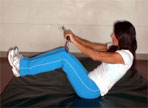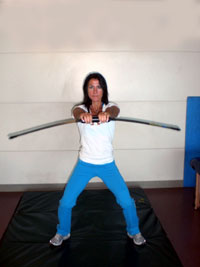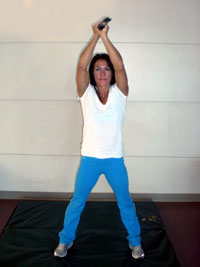
The Bodyblade is a piece of equipment that is popular in
many physical therapy clinics. It was invented by a physical
therapist, Bruce Hymanson, who was initially seeking to
create an exercise regimen that would train the muscles
around the shoulders without forcing the joint to initially
go through a wide range of motion, thus minimizing pain (1).
The Bodyblade is composed of a one-and-a-half pound flexible
foil ranging from two-and-a-half to five feet long, with a
handgrip right in the middle (1). “When using the Bodyblade,
the posture of the user, the position and orientation of
blade, and the amplitude of the oscillations will determine
which specific muscle groups are being targeted and their
level of activation. The Bodyblade may be held in 1 or 2
hands, but to achieve oscillation at its neutral frequency,
motion in the user’s trunk and proximal arm muscle must be
minimized; excessive trunk or arm motion interferes with the
coordination necessary to isolate reciprocal motions to the
hand (2).”
Bodyblade claims to assist with developing increase muscular
strength and endurance, increasing joint mobility and range
of motion, and enhancing coordination and posture (1). They
report that in just one minute, the ends of the Bodyblade
are said move back and forth up to 270 times. The resistance
needed to control the blade can range from 1 to 34 pounds
depending on the amplitude of the flexing tips (1).
In a study by Moreside et al. (2), they analyzed the trunk
muscle activation patterns, spine kinematics, and lumbar
compressive forces that occur when utilizing the Bodyblade
in 14 healthy male subjects. Their study found that
depending upon the orientation, amplitude of oscillation,
and specific technique, the Bodyblade may either enhance or
compromise spine stability. They also found that associated
lumbar compressive forces may be inappropriate for some
individuals with compressive lumbar spine pathology.
However, specific techniques appear to be effective for
recruiting spine stabilizers.
In another study by Lister et al. (3), they studied the use
of the bodyblade, cuff weights and Thera-band to determine
which device would produce the greatest muscle activity of
the scapular stabilizers during a typical rehabilitation
session. Their study involved a sample of 30 collegiate
athletes. EMG data were collected from the upper trapezius,
lower trapezius, and serratus anterior of subjects' dominant
shoulders during flexion and abduction using Bodyblade, cuff
weight and Thera-Band resistance. They concluded that the
Bodyblade produces greater scapular activity than
traditional resistance techniques.
Although studies have shown some positive results with the
use of the Bodyblade, further studies should be conducted in
a population that have medical issues. In the physical
therapy clinic great care should be taken to select which
patient would be an appropriate candidate for its use.
Supervision of the patient when utilizing the Bodyblade is
also important, as improper posture and use of the Bodyblade
may not only impede gains but worst yet, result in an injury.
Listed below are some sample exercises involving the
Bodyblade (1).
Click here for the full wall chart exercise guide involving
the Bodyblade.
 |
"Ab Crunch -
Position Bodyblade so the flex of the blade will
bend toward the floor and up toward the ceiling.
When holding the blade in front of your body, you
should see the narrow edge. Maintaining this
position, moving high, or low will challenge lowr
abs, upper abs, and lats. Try moving through a range
of motion for advanced training. (1)" |
 |
"Back and Shoulder Reach -
Hold Bodyblade so you can see the decal (flat edge).
Raise over head and assume a wide stance. Slightly
unlock the pelvis with an anterior pelvic tilt
(slight hollow in back). This will enhance the
entire trunk and extremities with great to the deep
and superficial postural muscles. Add a little
variety by rotating left and right or laterally
flexing from side to side. (1)" |
Last revised: October 6, 2009
by Jennifer Hill, MPT, CSCS & Chai Rasavong, MPT, MBA
REFERENCES
1.
http://www.bodyblade.com
2.
Moreside J et al. Trunk Muscle Activation Patterns, Lumbar Compressive
Forces, and Spine Stability When Using the Bodyblade. Physical Therapy.
Volume 87, No. 2, February 2007, pp 153-163.
3.
Lister J et al. Scapular Stabilizer Activity During BodybladeŽ, Cuff
Weights, and Thera-BandŽ Use. The Journal of Sport Rehabilitation. 16(1),
February 2007, pp 50-67.
|








